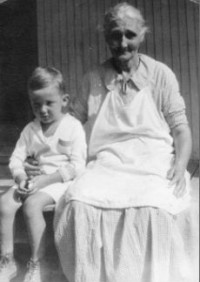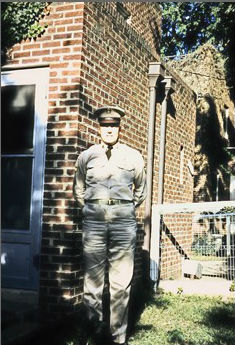Reprinted for the Island Free Press.

OCRACOKE — “What a story, if only the live oaks could talk.”
Supporter Spotlight
That is the caption Earl O’Neal of Ocracoke wrote for a photograph of the Outer Banks, as portrayed in his latest, almost completed book: A Historical Almanac of the Outer Banks; A Long Voyage Over the Last 488 Years.
The book, co-written with Mel Covey of Hatteras Island, is a pictorial history of the Outer Banks and includes Portsmouth, Beacon and Shell Castle islands.
The same statement could be applied to Earl O’Neal himself — what a story.
In O’Neal’s yard on Back Road is a special live oak, named the Buttonhole Tree by his deceased wife, Dee. It could probably tell some great tales about O’Neal and all his undertakings throughout his life, if it could only talk.
Earl O’Neal Jr., 85, has island roots on his father’s side that go back to the early 1700s and include many of the original Ocracoke families. The son of Earl Williams O’Neal and Luisa Gutt, an immigrant from Prussia, he grew up in Philadelphia. He spent his summers at his father’s home island and was christened at the house of his grandfather, “Pop-Pop Ike” (Isaac Willis O’Neal), in Ocracoke at the age of 5 weeks.
Supporter Spotlight

O’Neal’s memories of those summers include sitting on the porch with his grandfather, who told him stories of the sea and taught him to tie knots; going out to the duck blinds to hunt ducks and geese with his Uncle Rashe and his father; and fishing for bluefish and trout off the side of the mailboat, The Ocracoke. He recalls with delight the still warm, light rolls with butter his grandmother Helen made and eating 18 of them before dinner one day. Movies at the Wahab Village Motel, dances at the Spanish Casino and sailing in his Uncle Wahab’s sailboat are some of his other treasured memories.
Also etched into O’Neal’s memory is his Pop-Pop’s Model T (or A) car, which he says his grandfather had driven through the side of Old Bob’s stable on the day he got it. Later, when the three-year-old O’Neal was at the morning service of the Northern Methodist Church next to his grandparent’s home, he saw the car go by and yelled out, loud enough for all to hear: “There goes Pop-Pop’s car!”
O’Neal laughs as he tells this story: One dark, moonless night, when he was about 6 years old, he went flounder gigging with his dad, Oscar Jackson and Sam Keech in a sailboat. They sailed out the creek and anchored in shallow water. Then they took their kerosene lanterns and flounder gigs and proceeded to gig about 40 fish, which they strung on a big line, carried between two of the men. At that point, they realized that they had forgotten to leave a lantern on in the boat. They were unable to find it in the pitch dark and, finally, had to wade to the shoreline and find their way through the trees and underbrush to walk home. Someone went back for the boat the next day.
O’Neal’s father went north to find work, as did many Ocracoke men in the early 20th century. He had a job as a rigger’s helper at the Philadelphia Navy Yards, and according to O’Neal, he opened his home to friends and relatives from Ocracoke who came looking for work during the Great Depression. O’Neal grew up in a row house that was only 12-feet wide. He got a job at the age of 8 running errands for a candy store, and by 12, he was unloading lumber trucks for a company called Arctic Refrigeration.
He joined the Navy Reserve in 1948 and during the Korean War enlisted in the Army Signal Corps. He was selected as one of the first eight people to work at the Army’s experimental nuclear power plant in Idaho. He went on to earn a diploma in nuclear engineering from the University of Virginia and worked on ways to use nuclear energy for peaceful purposes, such as the generation of electricity.

Early on, O’Neal had met a young woman, Delores Grace Collins, at a Philadelphia trolley stop and had fallen in love. They married in 1955. O’Neal and Lori, as he fondly called her, spent their two-week honeymoon at Ocracoke, where, “Lori, Uncle Rashe and I had a great time and spent a lot of time at the beach.” O’Neal adopted Lori’s daughter, Sharen, and they later had a son, Mark.
O’Neal and his wife, who came to be known as Dee to most islanders, moved to Ocracoke in 1990, building a home where his grandparents’ house had stood. He has since devoted himself to learning and writing about all aspects of Ocracoke history.
He is the author of a number of books, covering such topics as the Coast Guard and Navy base during World War II, the history of island families and an autobiography titled One Boy’s Life. He designed Ocracoke’s Civil War marker that is part of the Dare County Civil War Trail and was instrumental in the placement of two World War II markers on the island. He lectures about island history and has served as chairman of various Ocracoke boards and committees. He was a director of the Graveyard of the Atlantic Museum in Hatteras and an associate for the Outer Banks History Center in Manteo.
O’Neal in 2009 was awarded North Carolina’s highest civilian honor, the Order of the Long Leaf Pine, for service to his community.
While he has suffered some health setbacks recently, sending him to Florida for the winter, O’neal hopes to return to Ocracoke in the spring to finish his book and to continue exploring and writing about Ocracoke history.







